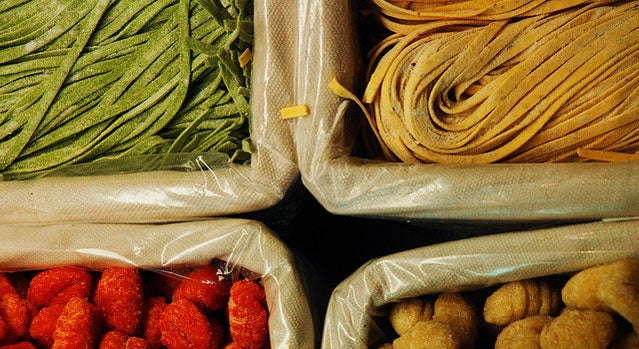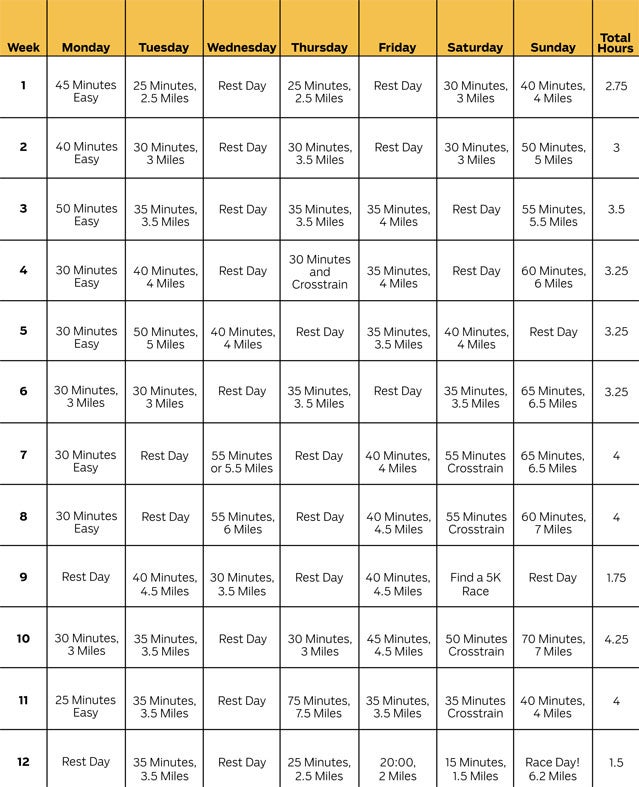You know the drill. Starting January 1, coworkers will start to complain about their holiday health transgressions. They’ll swear by a fitness-inspired New Year’s resolution, and maybe even start an office weight-loss pool, with participants’ weekly weigh-ins dominating water cooler conversation for a month. (Yawn.)
Screw tradition. Challenge your coworkers to race one of dozens of New Year’s Day 10K’s—or any other 10K throughout the year—and then destroy them. Instead of betting on Daryl’s final weigh-in, put money on the race. Then cash in with our 12-week plan.
Sound too ambitious for the day after the year’s biggest party? Don’t worry, most races start at a reasonable hour. Plus, it’s only 6.2 miles. We’ve assembled the best 10K brains in the business so that when the pain starts you’ll embrace it and aim for some hardware.
And remember, just because you’re not running the Boston Marathon doesn’t mean you can’t brag. Just ask Pete Rea, the coach of Olympic hopefuls at North Carolina’s Zap Fitness. “The best 10K runners have the strength of a marathoner and the economy and speed of a miler,” he says.
The Ultimate Race Day Nutrition Plan
Join the Outside Fitness Center and you can sign up for the interactive version of this training plan. You can map your runs, track your progress, receive daily e-mail reminders, and watch instructional exercise videos.
The Top 10 Tips for Running a 10K
Coach Pete Rea and Olympian Abdi Abdirahman share their secrets for running a personal best

Abdi Abdirahman
 Abdi Abdirahman
Abdi AbdirahmanRunning a 10K feels like “dealing with a mild hangover from start to finish,” says Rea. In short, it’s perfect for New Year’s Day. Presenting a quick list of everything you need to know to cross the finish line in personal record time, from the start of your training to post-race recovery.
Your advisers:
Pete Rea and Abdi Abdirahman, three-time Olympian and four-time USA 10K Champion.
1. Find a training partner.
A partner will keep you honest and help you stick to the program. “If you’re running by yourself, you can always make excuses not to train,” says Abdirahman. When you train with someone, you have to be there. No excuses.
2. Race before your race.
“Never have just one major race you’re prepping for with nothing along the way,” says Rea. Need motivation to do your tempo run? Jump into a local 5K five weeks into your 12-week training plan. As an added bonus, you can work on fine-tuning your race nutrition before your main event.
3. Caffeinate
While some question its use before a race, Rea is a proponent of caffeine in limited quantity. In general, he likes to take in 100–200 mg of caffeine—the equivalent of an eight-ounce cup of coffee—40 to 45 minutes before the race starts. Not only will it wake you up, but it will also reduce your overall perception of effort, says Rea. Experiment early on during training runs to find out what works for you. “I wouldn’t wait to find out you’re the person who takes four sips of caffeine then your whole gastrointestinal system turns to mush and you’re crapping everywhere,” says Rea.
4. Stick to what you know on race day.
Your pre-race dinner, your breakfast, your warm-up—all of that should replicate waht worked during training. If you didn’t usually drink caffeine in the weeks leading up to the race, don’t do it before the starting gun. “Whatever you do on race day should have been practiced every single time you did a hard workout,” says Rea.
5. Warm up.
Don’t let your warm-up be the first two miles of your race. Jog easy for 10 to 15 minutes, then throw in a few 100-meter accelerations to get your heart rate up, so you’ll be ready to go at race pace when the gun goes off. “If you’re not warmed up, your muscles aren’t as viscous, your body won’t rid itself of waste product as effectively, and you’ll have to run your first mile slower,” says Rea.
6. Chill out.
Abdirahman likes to keep to himself on race morning and listen to music by artists like U2 and Jay-Z so he can stay relaxed. There will be a lot of other nervous people at your race chattering away about splits and PRs and strategies. Don’t let their worries become yours.
7. Run your own pace.
If you’re doing the race with someone and he goes out too fast for you, don’t run with him. Determine your goal pace by doubling your 5K time and adding a minute or a minute and a half, then stick to it. “Keep a check on your excitement, and enjoy the race,” says Abdirahman.
8. Strategize.
“The most effective way to run a fast 10K is to run the second half faster than the first,” Rea says. Dial back the first two to three miles, running two to five seconds per mile slower than your race pace, so you feel controlled—almost like you’re going a little too slow. Then open it up on the back half. Pick it up to goal pace for four miles, then if you’re feeling good, it’s game on to the finish. Check out the course profile before racing. If the first half is flat or downhill and the back half is more challenging, this strategy won’t work. Try to even split the course by starting out at your goal pace and holding onto it through the finish line. Got a flat course or a downward slope on your last 5K? Plan to run the last portion faster than the first.
9. Embrace the pain.
The burning pain you feel while running a hard 10K is from lactate building up in your muscles—the same pain you get from lifting heavy weights. It should go away five to 10 minutes after you finish. “When you cross the finish line and you’ve accomplished your goal, all the pain that you went through while running goes away. That’s the happiest moment of the race,” Abdirahman says.
10. Walk it off.
Grab some water and get in some calories when you finish, then keep moving. A 20-minute walk will help your recovery. Once you’ve cooled down, put your legs in cold water for 12 to 15 minutes to help reduce inflammation. “The single worst thing you can do is cross the finish line, throw on your sweatpants, jump in your car, and drive home,” Rea says. “In terms of recovery, you’ll be a mess for the next threeo r four days.”
The Ultimate 10K Race Day Nutrition Guide
Race your heart out without spilling your guts

You’ll most likely be racing for an hour or less, but that doesn’t negate the need for proper nutrition. Presenting a simple strategy from New York City runner, registered dietitian, and sports nutrition specialist, Lauren Antonucci.
Pre-Race Dinner
Don't overload on carbohydrates, or you’ll risk feeling stuffed and sluggish in the morning Eat as much as you normally would, substituting a few extra carbs for your usual fish or salad if you want. Try loading 50 to 75 percent of your plate with complex carbs like pasta, potatoes, quinoa, or, Antonucci’s favorite, pancakes. Then fill in 25 percent with lean protein like chicken, turkey, fish, or eggs. A small amount of fat—olive oil on your pasta or the yolks from the eggs—should finish off your meal. If you must have your salad or veggies, keep the portion small, as this meal should be low in fiber.
Breakfast
Aim to take in 16 to 24 ounces of fluid. It's best to get in come carbs by drinking a sports drink, but at least drink water. If your stomach can handle solid food race before a run, gor for it. Solid breakfast ideas include toast with jam, a bagel with peanut butter, oatmeal with a banana, or even a salted baked potato. As for caffeine? Antonucci recommends decreasing your usual caffeine dose by 50 percent (unless you’ve honed your caffeine intake at previous races, like Rea has). Your pre-race excitement combined with excess caffeine could force an inopportune pit stop.
During
What you take in during the race depends entirely on race conditions. If it’s hot or you're running at altitude, you may need fluid. Go by thirst. Otherwise, Antonucci says, you should be able to make it through without refueling.
Post-Race
“Respect the 10K,” Antonucci advises, especially if you’re new to the distance. It is an endurance event, so you need to refuel properly to aid muscle recovery. Try to drink something within 30 minutes of finishing. A recovery drink with protein and carbohydrates, like Gatorade’s G Series Pro 03 Recover shake or Endurox R4 powder dissolved in water, is a good place to start.
Recovery may take a week or so and lead to some hobbling across the office. If it does, don’t worry. That medal prominently dangling from your bulletin board will eliminate any need for an explanation.
Want more info on proper sports nutrition? Contact Antonucci at www.nutritionenergy.com
10K Training Plan
Our 12-week program will prepare you to run a personal best

Follow the daily mileage and times in the chart above to run your best 10K ever.
For a more detailed interactive plan including videos, e-mail reminders, and the ability map your run, track your progress, sign up for our 12-week online training program.

